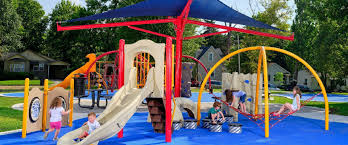Playgrounds are crucial to a child’s development as they offer physical activities, social interactions, and exploration opportunities. Nevertheless, it is essential to ensure the playground equipment is safe to prevent accidents and provide secure places for children to learn and have fun. With numerous options available today, choosing appropriate playground equipment may seem overwhelming.
How To Choose Safe Playground Equipment
Read through this comprehensive guide, where we will discuss critical considerations for selecting safe playground equipment for your school, community park, or backyard:
- Compliance With Safety Standards – The first thing you must do when buying any plaything is ensure it meets all necessary safety requirements. Look for items that conform to existing safety standards and International Play Equipment Manufacturers Association (IPEMA) guidelines, among others. Such regulations cover various aspects, including material quality, design features like height limits or gaps between components, installation procedures, etc., to reduce the chances of injuries occurring while using them.
- Design appropriate for age groups—Another essential factor that should not be overlooked during the selection process involves considering different age groups using these facilities because they vary significantly in physical abilities, coordination levels, and cognitive skills, among other things. For instance, play structures Canada, meant for younger children, should have lower heights with gentle slopes plus fewer complex parts, whereas those designed for older kids can include more advanced elements such as climbing walls or ropes courses.
- Fall surface and surfacing materials—The type of surface surrounding play sets significantly impacts preventing injuries resulting from falls; hence, the need to choose the right kind depending on specific needs. This means going for materials that can adequately absorb shock and have a sound drainage system so they do not become slippery when wet. Examples include rubber mulch,poured-in-place rubber, or engineered wood fiber, which provides excellent cushioning.
- Layout and spacing of playgrounds—Although it might seem obvious, how equipment is arranged within an area dramatically determines whether or not children will have safe playtime. Therefore, ensure enough clearance between different structures to avoid collisions and ease supervision. Also, keep spaces with only a few items so kids find it easier to move freely without bumping into each other all the time. In addition, separate zones for various ages can prevent accidents due to different levels of skills and physical abilities.
- Maintenance & inspection – Regular maintenance forms part of an integral process ensuring safety standards are always met when dealing with these facilities. Thus set up a schedule that includes checking worn-out parts, and loose screws/ bolts, among other things that may pose threats if left unattended for long periods. Fix things without delay.
While letting children use play structures in Canada, proper adult supervision and enforcing rules to keep everyone safe are equally vital. Have adults around who can monitor what happens at every point during their stay and intervene where necessary.
Depending on the age limits provided, establish clear guidelines about expected behavior while playing, such as not pushing others down and staying away from areas not designated for climbing.


